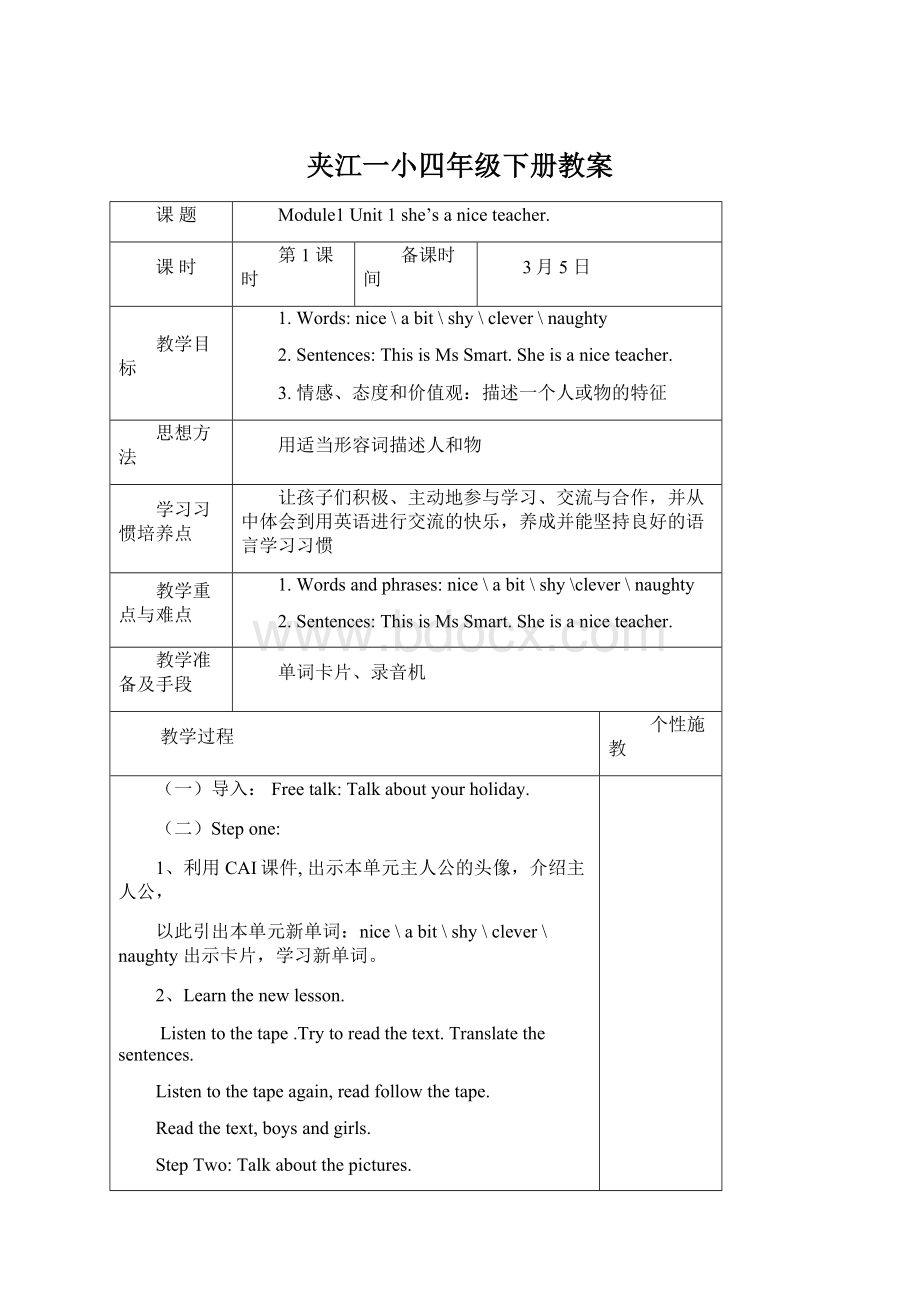 夹江一小四年级下册教案Word文件下载.docx
夹江一小四年级下册教案Word文件下载.docx
- 文档编号:21794885
- 上传时间:2023-02-01
- 格式:DOCX
- 页数:36
- 大小:30.30KB
夹江一小四年级下册教案Word文件下载.docx
《夹江一小四年级下册教案Word文件下载.docx》由会员分享,可在线阅读,更多相关《夹江一小四年级下册教案Word文件下载.docx(36页珍藏版)》请在冰豆网上搜索。

Talkaboutyourholiday.
(二)Stepone:
1、利用CAI课件,出示本单元主人公的头像,介绍主人公,
以此引出本单元新单词:
nice\abit\shy\clever\naughty出示卡片,学习新单词。
2、Learnthenewlesson.
Listentothetape.Trytoreadthetext.Translatethesentences.
Listentothetapeagain,readfollowthetape.
Readthetext,boysandgirls.
StepTwo:
Talkaboutthepictures.
Closeyourbooks,showthepictures(parrot,Xiaoyong,Maomao,MsSmart)
Example:
(1)ThisisParrot.Parrotisaverynaughtybird.
(2)ThisisXiaoyong.He’sacleverpupil.
StepThree:
Usingadjectivestodescribeperson.利用实物投影展示学生带来的照片。
(Describethepersonusingtheadjectives)
(三)Game:
接龙游戏
Example:
A:
I’mXiaoLan.I’mabitshy.
B:
XiaoLanisabitshy.I’mZhangYong.I’mverynayghty.
C:
ZhangYongisverynaughty.I’mJim,I’maniceboy.
板书设计
Unit1she’saniceteacher.ABCD
nice\abit\shy\clever\naughty
ThisisMsSmart.
Sheisaniceteacher.
个性作业
Homework:
Describethepersonusingtheadjectives
教学反思
Unit2He’scool.
第2课时
知识与技能:
cool\little\cute.
Thisisthisismybigbrother,He’scool.
情感、态度和价值观:
根据每个人的特征并用适当的词来修饰。
德育目标:
培养对家人的关心和爱护。
对比、家庭成员的特征
让学生积极参与口语交际
Wordsandphrases:
cool\little\cute.
Sentences:
Thisisthisismybigbrother,He’scool.
1、Song:
RowRowRowyourboat.
2、Freetalk:
Usingadjectivestodescribethepoem.
(二)探究新知Stepone:
Warmer:
Usingtheadjectivestodescribeyourclassmates.
①ThisisXiaoyong.Heisacleverpupil.
②ThisisYuanjiaqi.She’sveryclever,butshe’sabitshy.
Listenandpoint.
(1)Pointoutthedifferentmeaningsoftheword“cool”.
Inthisunit,“cool”meansfashionable,anditismostcommonlyusedtomean“quitecold”.Theword“cool”hasothermeaningsaswell,buttheyareonesthatthestudentsareunlikelytocomeacrossinthefuture.
(2)Listentothetapeandunderlinethenewwords.Writedowntheseadjectivesontheboard,andthenlearnthesenewwords.
Listentothetapeagain.Readthetext.
Closeyourbook.UseCAIshowsthepicturesoftext.Choosesomestudentstodescribethepictures.
Listenandsay,thensaythepoemanddotheactions.
Playthespokenversionofthepoem.Andhavethestudents.Repeateachline.Playthetapeandhavethestudents.
(三)巩固新知Tellthestudentsthattheyaregoingtoworkingroupsofthreeorfour.
DotheABunit2.
Game:
Explainthattheyaregoingtoplayagamewheretheyhavetowhispersomeinformationtotheirclassmate.Thatclassmatehastowhispertheinformationtothenextperson.
Thelastperson.Thatpersonhastosaythathe\sheheard.
Then,theotherstudentslistencarefullytofindoutifthemessagehaschangedatall.
littlesister---cute
father---clever
friend---naughty
mother---nice
bigbrother---cool
能用英语表述一个人的性格
Module2Unit1Londonisabigcity.
第3课时
3月5日
ship,cityt,beautiful,whose
London.isabigcity.
Myhouseissmall,butit’sbeautiful.
了解国外著名的旅游景点
学语言就学她的语言文化背景
Words:
capital,about,beautiful
LondonisthecapitalofEngland.
It’sverybigandverybeautiful.
Chant:
Thisisalittlegirl,andshehasalittlecurl.Andwhensheisgood,sheisvery,verygood.Andwhensheisbad,sheisvery,verybad!
TalkFree:
T:
Hello!
Boysandgirls.I’mateacher.Areyouateacher?
S1:
No,I’mnot.
S2:
No,I’mapupil.
Areyounaughty?
S3:
Areyouclever?
S4:
Yes,Iam.……
(二)探究新知Step一、导入
利用卡片教授“city”,反复领读,读熟之后带入句子“Londonisabigcity.”中。
ThentranslateitintoChinese.”鼓励学生踊跃参加抢答赛,学生可以用中文说。
Step二、新授
在愉快的氛围中,师告诉学生:
“Amy和Lingling是同班同学。
一天,Amy带来了一本关于自己家乡—伦敦的书。
Lingling看见这本书后非常好奇,于是就请Amy向她介绍伦敦的情况。
现在我们就来跟Amy学一学怎样描述城市和景物。
今天学习过后,请大家也来介绍一下自己熟悉的城市、地区或景物。
请学生听录音,听一听Amy和Lingling之间的对话。
师:
“WhereisLondon?
”生在地图上指出伦敦的位置。
再放一遍录音,让学生在自己的书上勾出描述城市的形容词(nice,big,beautiful,small)。
请学生根据插图和上下文猜一猜每个生词的意思。
“beautiful”一词教师要反复示范,借助肢体语言帮助学生读清并理解这一单词。
个别单词处理完之后,教师领读课文几遍。
然后鼓励学生分角色大胆试读,教师及时给予表扬。
(三)巩固新知练习
完成SB第一单元活动3。
把全班分成两人一组,分别扮演Amy和Lingling,进行问答练习。
例如:
What’sthis?
B:
It’sabookaboutLondon.It’sverynice.
Unit1LondonisthecapitalofEngland.
It’sabookaboutLondon.
LondonisthecapitalofEngland.
作业布置:
去描述一个名胜古迹的特征
Unit2It’sveryold
第4课时
old,famous
ThisistheBigBen.It’soldandtall.
图览大本钟、海德公园和伦敦塔桥
通过图览这四个名胜古迹了解更多的地理知识
让孩子们积极、主动地参与学习、交流与合作,并从中体会到用英语进行交流的快乐。
long,old,famous
ThisistheBigBen.It’soldandtall
Grammar:
Usingadjectivestodescribecitiesandbuildings.
单词卡、录音机
导入:
Talkabout:
Usingadjectivestodescribeaperson’spersonalityandLondon.
Stepone、Warmer:
Reviseadjectives.TellthestudentsthatIamgoingtosayanadjective.Theyhavetofindsomethingintheirbooksthattheadjectivedescribes.Asktwoorthreestudentstosaywhichobjectthechose.
Example:
It’sbig.S1:
(pointstoLondon)London.
(pointstoelephant)Elephant.S3:
(pointstoBeijing)Beijing.
Domoreexampleswiththeclass.
Steptwo、Listen,pointandsay:
1、Listen,pointandfindoutthenewwordsandunderlinethem.Thenrevisethemusingcardsorpictures.(Writedownthesewordsontheboard.)
2、Afterdoingthis,tellthestudentstoclosetheirbooks.Iamgoingtosaythefirstwordofatwo-wordplacename.TheseplacesareallinLondon.Thestudentshavetosaythesecondwordofthetwo-wordname.
Buckingham…Ss:
…Palace.
Hyde…Ss:
…Park.
3、Havethestudentscontinuetheactivityinpairs.Theyshouldtaketurntosaythefirstword.
4、Showingfourpicturesonthescreenabout"
theRiverThames"
"
BigBen"
HydePark"
and"
TowerBridge"
.(Writedownthesewords.)Thesametime,Iamgoingtoreadthetextforthestudents.Havethemrememberthesentences.Thesecondtimes,asksomestudentstointroducethepictures.
5、Games:
Guessinggame.
6、DoABUnit2exercise1.Quiz:
Listenandsaytheanswers.
7、ShowingABUnit2exercise2onthescreen.Dothisexercisetogether.
StepthreePractice
1、DoSBUnit2activity4.Listenandpoint.First,havestudentssaysomethingaboutthesepictures.Thenlistenandguesswhichoneisright.
2、DoABUnit2exercise4.Writeaboutyourschoolbuilding.
Stepfour、Learntosing
1、Havethestudentslookatthepictureanddescribeit(childrenplayingagame).
2、Tellthestudentsthatthissong,'
LondonBridgeisfallingdown'
isatraditionalEnglishsong.ExplainthatLondonBridgeisaveryfamousbridgeinLondon.
3、Playthespokenversionofthesongandhavethestudentsrepeateachline.Playthetapeandhavethestudentssingthesong.
4、Explaintheactionsandhavetheclasssingthesongagain.Choosesomestudentstocometothefrontandplayit.Let'
ssee"
Whoisthewinner?
"
Havethestudentssinganddotheactionsafterclass.
Module2London
Unit2It’sveryold
BigBen——oldandtall
HydePark——beautiful
TowerBridge——famousandbeautiful
Homework:
了解英国的四大名胜古迹
Module3Unit1Robotswilldoeverything.
第5课时
3月12日
1.Sentences:
Oneday,robotswilldoeverything.
2.Wordsandphrases:
roboteverythingonedayhouseworklearnourthat
3.Usingwilltodescribethingsinthefuture
对机器人将来能力的期待
要养成好习惯、自己的作业自己完成
培养听读好习惯
2.Wordsandphrases:
robot、everything、oneday、housework、learn、our、that
Usingwilltodescribethingsinthefuture
(1)Warmingup:
---Greeting.
Listenandact:
e.g.washclotheswatchTVrunwalkplaythefluteplayfootballjumpdohomeworkmakeacakerowaboatplaytabletennis(运用肢体语言来复习动词及动词词组,为本课will的学习做好铺垫)
(二)探究新知
(2)Presentation:
Showarobottotheclassandsay“Todaywe’regoingtotalkabouttherobots.”
Describingtherobots,itcansing.Itcandance.Oneday,robotswilldoeverything.(运用图片展示robot的含义)
Asktothestudents“Whatelsewilltherobotsdo?
”ShowtheCAItostudents.(让学生看课件了解机器人能做什么不能做什么)
Nowshowthetexttothestudents.Lookatthebookandask.WhatcanDaming’srobotdo?
Willrobotsdothehousework?
Willrobotshelpchildrenlearn?
...
Writetheanswersontheboard:
Itcanwalk.
Thendrillthissentenceandthenchangetheword“walk”.
Talkaboutthesentences:
Theywilldothehousework.Theywillhelpchildrenlearn.
WritethesentenceontheboardOneday,robotswilldoeverything.(用磁卡带替换动词及动词词组,让学生运用所学。
同时理解oneday的含义)
Continuethewordslearning:
houseworkhelpchildrenlearn…
Ingroups,talkabouttherobotsthenreport.
(三)巩固新知(3)Practice:
DoexercisesinAB.
Inpairsactthetext.
Drawarobotandsaywhattherobotcando.Inpairsoringroupsthenreport.
Production:
LookatExercise3inthebookandtalkaboutwhattherobotswilldointhefuture.
Guesswhattheirrobotswilldo.Then
- 配套讲稿:
如PPT文件的首页显示word图标,表示该PPT已包含配套word讲稿。双击word图标可打开word文档。
- 特殊限制:
部分文档作品中含有的国旗、国徽等图片,仅作为作品整体效果示例展示,禁止商用。设计者仅对作品中独创性部分享有著作权。
- 关 键 词:
- 夹江 四年级 下册 教案
 冰豆网所有资源均是用户自行上传分享,仅供网友学习交流,未经上传用户书面授权,请勿作他用。
冰豆网所有资源均是用户自行上传分享,仅供网友学习交流,未经上传用户书面授权,请勿作他用。


 对中国城市家庭的教育投资行为的理论和实证研究.docx
对中国城市家庭的教育投资行为的理论和实证研究.docx
